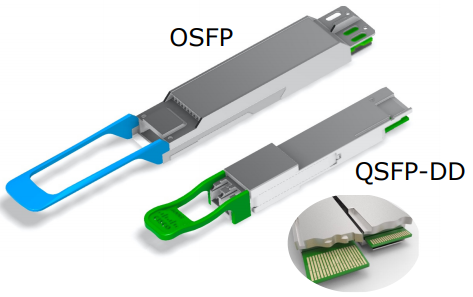
QSFP-DD vs OSFP: What’s the Difference?
QSFP-DD vs OSFP: The 400G Battle in Data Centers—How to Choose Wisely?
As 400G networks move from lab testing to large-scale deployment, data center engineers find themselves facing a “sweet dilemma.” QSFP-DD and OSFP—two advanced optical module form factors—are like top-tier racecars, each with its own strengths. As someone who works closely with switches and fiber optics every day, let me walk you through how to choose between them.
First Things First: Who Are These “Contenders”?
QSFP-DD: The “Upgraded Favorite” Evolved from QSFP28
QSFP-DD stands for Quad Small Form Factor Pluggable – Double Density. Think of it as an enhanced version of QSFP28. It expands the 4 channels to 8, each running at 50Gbps, achieving a total of 400G. Best part? Its size is nearly identical to QSFP28, so you don’t need to redesign your switch cages—huge cost savings for data centers.
Imagine you’ve already deployed lots of QSFP28 gear and now need to move to 400G. Choosing QSFP-DD allows you to keep your existing infrastructure and just swap out the modules, saving time and money.
OSFP: A “Purpose-Built” Contender for 400G
OSFP (Octal Small Form Factor Pluggable) is a brand-new form factor designed specifically for 400G. Like QSFP-DD, it uses 8 x 50G channels but comes in a larger form to improve thermal performance. While it’s not backward-compatible, its fresh design offers better scalability toward 800G and beyond.
For instance, in scenarios that demand exceptional thermal performance—like long-distance DWDM links—OSFP’s larger size and heat dissipation capabilities make a real difference.
Key Comparisons: Size, Cooling, and Compatibility
Size: QSFP-DD is Compact, OSFP is “Bulkier”
| Feature | QSFP-DD | OSFP |
|---|---|---|
| Width | ~18.35 mm | ~22.58 mm |
| Height | ~8.5 mm | ~13.0 mm |
| Length | ~89.4 mm | ~107.8 mm |
| Connector Pins | 76 (2 rows) | 60 |
| Backward Compatibility | Yes (with QSFP) | No |
QSFP-DD excels in maximizing port density within limited space. OSFP, while bulkier, offers more room for thermal design and future upgrades.
Thermal Design: OSFP’s “Natural Advantage”
400G modules generate a lot of heat, especially for long-haul coherent modules. QSFP-DD typically handles 12–14W of power; OSFP can manage 15–18W. That’s critical if your use case involves high-power coherent optics (e.g., DWDM).
Take intercity data center connections for example—where stable long-distance transmission is crucial—OSFP’s thermal advantages help maintain consistent performance.
Density: QSFP-DD Wins in High-Port Count Deployments
In a 1U switch, QSFP-DD supports up to 36 ports, while OSFP tops out at 32. That may seem minor, but in large data centers, 4 more ports per switch could translate into hundreds or thousands of additional server connections.
Real-World Applications: Each Has Its Strengths
QSFP-DD’s Sweet Spot
- Intra-data center connections: Short-reach server-to-switch links within the same rack or facility.
- Legacy infrastructure upgrades: For facilities already using QSFP28, QSFP-DD enables seamless 400G upgrades without forklift changes.
For example, in a cloud data center with heavy east-west traffic, QSFP-DD handles high-density short-reach links efficiently.
A financial institution that has already deployed QSFP28 modules across their infrastructure can upgrade to 400G using QSFP-DD without touching their switches—saving on costs and downtime.
OSFP’s Ideal Use Cases
- Long-haul transmission: Metro or backbone DWDM links, or inter-data center connectivity across cities.
- Futureproofing: Designed to scale to 800G and even 1.6T, OSFP’s thermal performance supports future optical evolution.
Telecom carriers or hyperscalers planning long-term network growth can benefit from OSFP’s thermal design when planning for future 800G+ infrastructure.
Looking Ahead: Which One Wins in the 800G Era?
Both QSFP-DD and OSFP already support 800G modules:
- QSFP-DD800: Continues to lead in port density and remains compatible with existing network designs.
- OSFP800: Offers superior thermal headroom, making it ideal for high-power coherent optics and future growth.
Summary: How to Choose?
Choose QSFP-DD if:
- You want to maximize port density in limited rack space
- You need backward compatibility with QSFP-based infrastructure
- Your applications are mostly short-reach intra-data center links
Choose OSFP if:
- Your use cases involve long-reach, high-power optical modules
- You plan to adopt 800G or higher in the near future
- You are building carrier-grade or hyperscale networks with long-term scaling in mind
In the end, it’s not a zero-sum game. Many data centers deploy both form factors—QSFP-DD for access and aggregation layers, and OSFP for core or metro backbone layers. After all, network agility and scalability are what matter most in the long run.